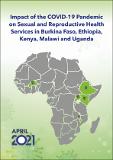Impact of the COVID-19 Pandemic on Sexual and Reproductive Health Services in Burkina Faso, Ethiopia, Kenya, Malawi and Uganda
View/
Publication Date
2021-04Type
Technical Reportviews
downloads
Metadata
Show full item record
Abstract/
Executive Summary Since the first case of Coronavirus Disease 2019 (COVID-19) was reported in China in late 2019, the ensuing global pandemic has challenged human health and development and hampered the attainment of global, regional, and national health priorities and development goals. In sub-Saharan Africa (SSA), where health systems remain fragile, the COVID-19 pandemic brought unprecedented disruptions to healthcare delivery and utilization. The policies and actions of certain governments to control the pandemic further exacerbated existing inequalities, especially for the most vulnerable groups (e.g., young women, adolescents, and sexual and gender minorities). So far, limited data are available to assess the impacts of COVID-19 on sexual and reproductive health (SRH) services. This report presents a comparative analysis of five SSA countries (Burkina Faso, Ethiopia, Kenya, Malawi, and Uganda), highlighting the overall impacts of the COVID-19 pandemic on the availability of, access to, and use of SRH services. We interviewed 3,473 women and girls, and 466 healthcare providers in Burkina Faso, Ethiopia, Kenya, and Uganda. In addition, we conducted in-depth interviews with 211 women and girls, 176 healthcare providers, 64 representatives from civil society organizations (CSOs) and non-governmental organizations (NGOs), and 13 policy makers (Ministry of Health officials) in the five countries (including Malawi). Findings show that, during the Pandemic, women and girls had limited access to critical SRH services – contraceptive services, antenatal care, post-abortion care (PAC), and HIV/AIDS prevention and management. Government restrictions and lockdowns in response to the relentless spread of COVID-19 limited access to SRH services and disrupted other sectors, such as transport, health, trade, and security. Some health facilities were closed and some were converted to COVID-19 isolation and treatment centers. As a result, women and girls had to go to other, more distant health facilities. These clients reported that the longer distances, combined with a fear of contracting the virus, the elevated cost of healthcare, and the occasional negative attitudes of providers, impeded access to SRH services. Notably, those experiencing difficulties in accessing SRH services sometimes stopped visiting health facilities all together, delayed or postponed care seeking, or utilized non-facility-based care. Some women and girls decided to treat themselves with over-the-counter medications, while others sought alternative care sources (traditional healers and birth attendants). At the same time, health providers reported reduction in the availability of some SRH services, including contraceptives, antenatal care, comprehensive abortion care, and sexual and gender-based violence (SGBV) services. Unavailability of these services was due to shortages of supplies, an absence of trained healthcare personnel (many of whom were redeployed to COVID-19 units), the infection of healthcare providers, staff reductions, and the closure of health facilities. Consequently, providers reported a decline in the use of SRH services during the pandemic that corresponded with increased difficulty in accessing (or the unavailability of) SRH services and an overarching fear of contracting the virus when visiting the health facilities. However, several facilities implemented innovative strategies to ensure continuity of SRH services, including the use of telemedicine, self-care approaches, changes in timing for services, and altering referral patterns for care services. The COVID-19 pandemic has had adverse effects on the availability of, access to, and utilization of critical SRH services across the five countries. These effects have led to, and continue to lead to, unmet needs for contraception, as well as limited access to and use of such services as antenatal care, PAC and HIV/AIDs, resulting in poor health outcomes. Therefore, the responses of governments to the pandemic must strike a delicate balance between mitigating the impacts of the virus and adopting multisectoral responses that are fit-for-purpose and address sexual and reproductive health needs, challenges and priorities.
Subject/
COVID-19; Sexual and Reproductive Health (SRH); Pandemic; Adolescents; Healthcare providers
Publisher
The African Population and Health Research Center (APHRC)Collections
- General - GEN [367]

